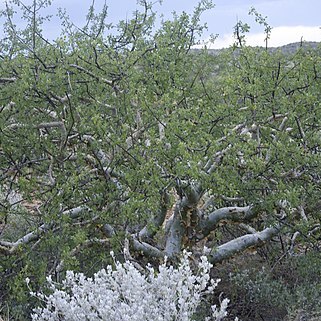A shrub or small tree. It grows 5 m tall. The bark becomes brown and flakes off. Young branches are densely hairy. The leaves have leaflets along the stalk. These can be divided. The leaflets are 6 cm long by 2 cm wide. The are narrowly oblong. There are rounded teeth along the edge. The flowers appear with the young leaves. They are in groups 8 cm long in the axils of leaves. The fruit are about 1 cm across.
Leaves pinnate with the leaflets 2–4-jugate or occasionally 3-foliolate; petiole up to 5 cm. long, pubescent; leaflets up to 6 × 2·3 cm., oblong, elliptic-oblong, ovate or rotund, apex acute or obtuse, margin crenate-serrate, base rounded or very broadly cuneate, slightly asymmetric, sparsely pubescent above, more densely so below, occasionally almost glabrous; petiolules up to 0·5 mm. long, pubescent.
Flowers appearing with the young leaves, in axillary dichasial cymes up to 8 cm. long or the female inflorescences reduced to 1–2-flowered abbreviated cymes; branches of inflorescence pubescent; bracteoles up to 3 mm. long, filamentous, pilose; pedicels up to 5 mm. long, slender, pilose.
Bush or small tree up to 5 m. tall; bark on older specimens chestnut-brown, polygonal-reticulate on bole, flaking in scales 2 cm. across, greenish on branches and peeling in papery buff strips; young branches densely pubescent.
Fruit 0·85–1·3 × 0·7 × 1 cm., ovoid-globose, minutely apiculate, glabrous; pseudaril covering up to 2/3 of the endocarp and becoming thin above; endocarp c. 1·1 × 0·8 cm., cordiform, smooth, both faces moderately convex.
Many-stemmed shrub or bush, up to 2.5 m high. Leaves sparsely pilose to pubescent, 3-foliolate or imparipinnate; lamina up to 90 mm long; terminal leaflet elliptic to obovate, 35 x 20 mm. Flowers yellow to green.
Petals 2·5–4 mm. long, pilose outside except towards the margins.
Calyx c. 4 mm. long, infundibuliform, lobed to 1/3-way, pilose.
Stamen-filaments flattened and broadened towards the base.
Disk-lobes not developed.


